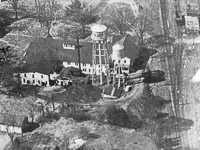Patent Medicines in the Age Before Scientific Pharmaceuticals
Late 1800s to the 1930s
My Wife's Grandfather worked as a chemist for The Tilden Company in Upstate New York during the early 1900s. As a result we came into possession of his Recipe Book
for the plethora of nostrums and remedies he helped create. Some of the ingredients are still sold today under various brand names. Some are humorous, others are forgotten, while still others are downright dangerous. The following installments are my exploration of this unique window into the medical past. [Note: We donated the actual book to the historical section of the National Library of Medicine.]
![The Tilden Company circa 1930 [source:NLHS] The Tilden Company circa 1930 [source:NLHS]](images/tilden-company-from-above.jpg)

The book is mostly a unordered compilation of the labels that appeared on the various products they sold. There are a limited number of handwritten notes as well. Here is the full first page.

The words Poison, Opium and Strychnine sort of jump off the page.
Good For What Ailes You
Let's look a bit closer a the bottom/center item Elixir Maltopepsin
.

Note the Alcohol component of 12-17%. This would presumably fortify
the patient. Alcohol was a common primary ingredient or base for many daily tonics. I wonder why?
Let's start with Maltopepsine. This appears to be a Tilden brand concoction of digestive enzymes and acids. A search yielded nothing current about it, but plenty of very old medical journals mention it. Here is a full page ad from the 1895 Journal of Materia Medica
.
![Maltopepsin Ad [source:google books] Maltopepsin Ad [source:google books]](images/tilden-maltopepsine-ad-1895.jpg)
The rationalization for it being a very perfect substitute
for missing (?) body fluids and relying on the indubitable testimony
of a few reliable
physicians is quaint but hardly evidence-based as they claim.
Moving on to the other ingredients, supplemental Iron (in alcohol of course!) may still be used as a tonic in some quarters. No big surprise there but it does have GI effects, mostly constipation.
The next ingredient is Quinine (of gin & tonic fame). During my early career it was given to patients with leg cramps. Apparently it helped because there was a hue and cry when it was taken off the market in the 2000s because it's also known to cause bleeding and arrhythmias. It is still used to prevent and even treat malaria.
Finally there's Strychnine!! Extracted from the plant Strychnos nux-vomica. It is a central nervous stimulant, anti-emetic, and at higher doses a deadly poison. According to the ad the elixir was used by pregnant women and infants. Yikes!
Most of these patent medicines had multiple active ingredients (the shotgun approach
) and were used to treat broad categories of symptoms and diseases. From the physician's standpoint this made diagnosis and therapeutic decisions rather simple.
Cerebral Sedative
Now let's consider the two labels marked Poison
near the top. I'll note here that these are the only oral medication labels in the collection thus marked.

Of course we start off with Alcohol 20%. Add a little Opium resin and you have a Tincture (one or more substances dissolved in alcohol). This is better known as Laudanum of novel and movie fame. The 40 M
may refer to molar concentration (?), but I can't pin this down.
The potent sedative Chloral Hydrate was in common use until a few decades ago. It may be the original date rape drug referred to as slipping someone a Mickey
(a frequent plot element in old movies). It was commonly used to treat psychiatric patients and children. It is no longer available in the US.
The sedative and anticonvulsant Potassium Bromide is no longer used in human medicine. Gelsemium is a native plant containing alkaloids related to strychnine.
Units of Measure
- M – molar concentration??
- grs (grain) – 1/7000th of a pound (this is where we get the odd size of a standard aspirin tablet (5 grains = 325mg)
- minim – 1/480th of a fluid ounce
- m – ?? short for minim?
- dram – short for drachm, 60 grains or one eighth of an ounce, or 60 minims or one eighth of a fluid ounce
Haimased
Next we'll consider the simpler concoction Haimased
that was prescribed for high blood pressure. It has just two ingredients: Alcohol (no surprise there!) and Sodium Thiocyanate.

Here is a description (ad?) from an Ohio medical publication:
Lower blood pressure effectively…safely, with this time-tested Sodium Thiocyanate formula. The proved clinical record of Haimased for 27 years and more than 1,500,000 prescriptions shows this to be the therapy of choice over the newer, potentially more toxic Hexamethonium-veratrum-rauwolfia preparations.
Bulletin of the Mahoning County Medical Society (1962)
The ingredient Sodium Thiocyanate was first used to treat hypertension around 1900. It was apparently effective and safe enough for the time. It is however unpredictable and potentially toxic and was taken off the market except as a treatment for cyanide poisoning.





































